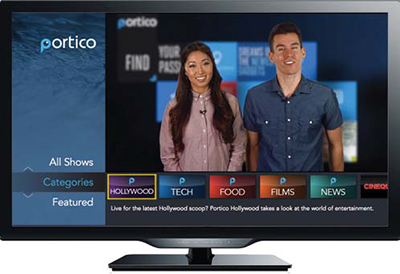‘Casting Wars’ Augur Next Airwaves/Attention Battle
Gary Arlen
Tom Morgan, founder and CEO of Net- 2TV, the developer and operator of Portico streaming video services, sees an opportunity for his company’s TV-like content package via a new array of wireless broadband channels being packaged for Verizon Wireless, AT&T Wireless and possibly other mobile and wireline carriers.
Morgan also expects a “casting war” as rival technologies battle to deliver wireless video content through the final few yards from wireless receivers, mainly tablets and smartphones, to big flat-panel display screens.
In Morgan’s vision, the handheld devices will become “tuners,” pulling IP video from LTE airwaves, then transmitting—or “casting”—the shows to the big screen. The casting confrontation will become a smackdown between protocols such as Google’s Chromecast, Apple’s Airplay and the Miracast peer-to-peer wireless screen-casting standard. It may take several years for a marketplace leader to emerge, but there’s no hurry since the surrounding infrastructure (including spectrum availability) will be a work in progress for several years to come.
Net2TV, in Redwood Shores, Calif., has an obvious stake in this process, if the casting wars rage on. Like other content producers and aggregators, the young company wants to make sure that its content reaches viewers’ preferred screens. Although other technology developments, such as the new “1 Mainstream” software-as-a-service (see below) would enable multiple-format delivery, the potential casting wars may create unanticipated hurdles for the creation of telco-run, end-to-end wireless programming services. Such program packages could compete with cable as well as broadcast.

Net2TV’s Portico user interface screen What follows is a speculative scenario, stitched together from a variety of sources, spurred by my conversation with Morgan and other interested observers.
TV-LIKE PROGRAMMING ENVIRONMENT
Portico’s aggressive drive to create a TV-like programming environment is a good example of the effort to develop over-the-top streaming video channels of news, lifestyle features and entertainment content; maybe even sports, if anyone can get the rights. Portico, which debuted in October, is believed to be negotiating carriage deals with wireless carriers as well as cable operators, who are also seeking IP content for their broadband packages.
Many other video content producers and aggregators are also likely to be negotiating with Verizon, AT&T and other carriers which are escalating their plans to create video channels to be transmitted via the TV spectrum they hope to acquire at FCC auctions.
Where’s the evidence for the telcos’ efforts to create a wireless, on-demand competitor for broadcast TV channels? Start with Verizon’s recent acquisition spree. In the past couple months, Verizon and its subsidiaries have snapped up Intel’s nascent “OnCue” Internet TV venture; Edgecast, the content delivery network service; and up- Lynx, a cloud-based streaming multiscreen video solutions provider.
Verizon CEO Lowell McAdam, at last month’s UBS Global Media and Communications Conference, called wireless broadband channels a “win-win” for all parties. He acknowledged that Verizon has had “lots of discussions” with sports leagues, which, he said, liked the idea of out-of-market video delivery. (He acknowledged that a major obstacle is distribution rights currently held by other TV networks.) McAdam did not reveal any specific plans, but just knowing Verizon’s intent to carry live sports via wireless networks adds to the credibility of such services.

Tom Morgan
Collectively, these new assets contribute to the growing expectation that Verizon, which has frozen its landlocked FiOS agenda, is now turning to the airwaves for multichannel content delivery. AT&T’s purchase of Qualcomm’s FloTV spectrum two years ago similarly set the stage for national delivery of IP video; overall, AT&T has been less acquisitive, but it is also believed to be stocking its arsenal to deliver wireless video.
Aiding and abetting this vision of home TV delivery via licensed and unlicensed wireless systems is technology such as WiDi (Wireless Display), developed by Intel, which enables viewers to stream or “cast” video and other content from a desktop — or in this scenario—a tablet or other portable device to any HDTV, UHD or other big-screen digital displays. WiDi supports HD 1080p video quality, 5.1 surround sound, and low latency for interacting with applications that are sent to the TV.
That’s a collection of capabilities that fits wireless carriers’ visions for multiple revenue sources as well as measurable interactivity (including video-on-demand). It also incorporates the home networking plans of many technology providers, including the casting wars combatants such as Apple, Google and Intel.
‘AN ART, NOT AN ALGORITHM’
Net2TV’s Morgan, a 30-year “new media” veteran, sees an immediate value in establishing content niches that will be embedded into the alternative video lineup before the casting wars begin.
“Our objective is to build new channels, longer-form content,” he said. He cites the twice-daily newscast (typically about 10– 12 minutes long) that Portico offers, curated from Associated Press video stories and hosted by a Portico anchor team.
“We clip out the [AP] intros… add familiar channel motion graphics,” Morgan said, then insert a couple of commercial pods, typically only two ads per break. With more and longer shows on Net2TV’s agenda, he said the goal is to provide a familiar TV experience to viewers watching on-demand Internet content, streamed via their tablets or other devices, and sometimes then “cast” onto their big-screen monitors.
Portico’s essential ingredient, Morgan insists, is its human decision-making process, contrasted with the automated curation of many other content aggregators and distributors.
“Television is an art, not an algorithm,” he said. “We have a production system that makes it easy for anyone to produce shows.”
MORE TOOLS
Indeed, the effort to create TV-like shows for Internet distribution is bubbling up as a major factor in the next phase of IP television. For example, last month 1 Mainstream debuted as a “software-as-a-service” platform that automates app creation and streaming; it also manages ad serving and billing for Internet TV devices.
The company, founded by former Apple, Roku and Tivo executives, is using scalable cloud technologies to provide native applications on a variety of platforms and CDNs. Its first customer is British Sky Broadcasting and its initial line-up of supported devices includes Apple TV, Google TV, Samsung Smart TVs, Roku, Xbox, iPad, Kindle Fire and Android tablets.
With this and other emerging tools, the Internet TV wannabes have plenty of resources to build and distribute the programming that will be part of the casting wars. The complicated interactions between content suppliers, such as Portico— and carriers, such as Verizon and AT&T— will shape the competitive home media landscape.
The casting wars—affecting the final delivery leg—and the big providers who want a stake in the wireless pipeline add more complexity to the evolving competitive landscape.
And that landscape is already perplexing for viewers and for those who want to control (or keep control) of the airwaves.
Gary Arlen is president of Arlen Communications LLC, a research and consulting firm. He can be reached atwww.ArlenCom.com.
Get the TV Tech Newsletter
The professional video industry's #1 source for news, trends and product and tech information. Sign up below.
Gary Arlen, a contributor to Broadcasting & Cable, NextTV and TV Tech, is known for his visionary insights into the convergence of media + telecom + content + technology. His perspectives on public/tech policy, marketing and audience measurement have added to the value of his research and analyses of emerging interactive and broadband services. Gary was founder/editor/publisher of Interactivity Report, TeleServices Report and other influential newsletters; he was the long-time “curmudgeon” columnist for Multichannel News as well as a regular contributor to AdMap, Washington Technology and Telecommunications Reports; Gary writes regularly about trends and media/marketing for the Consumer Technology Association's i3 magazine plus several blogs.

